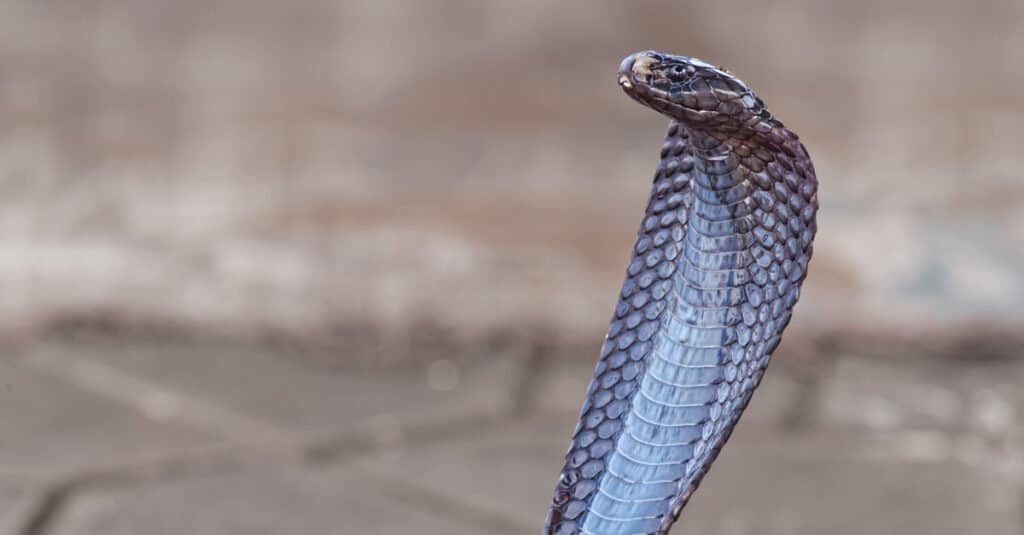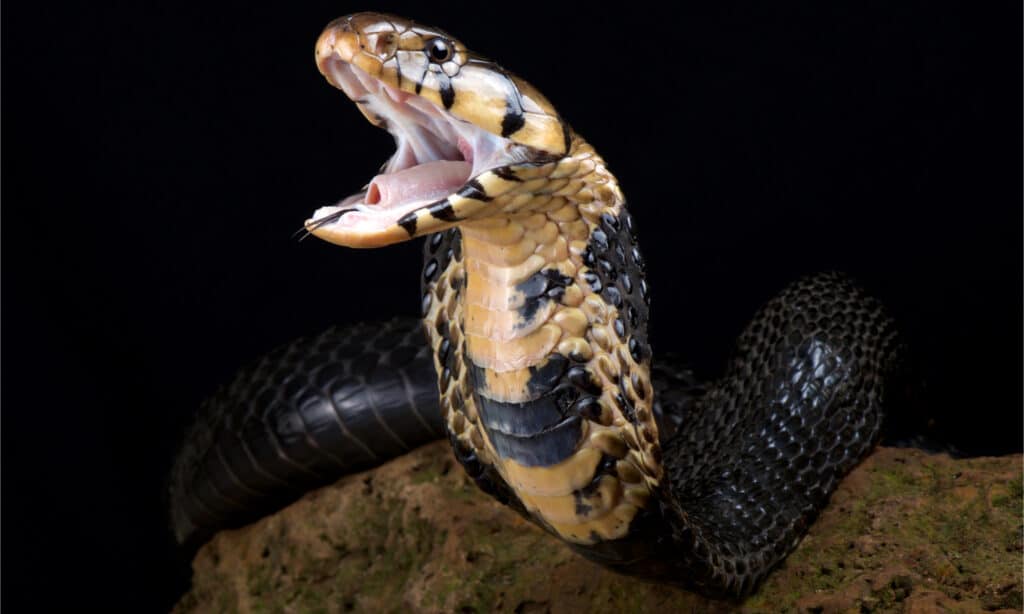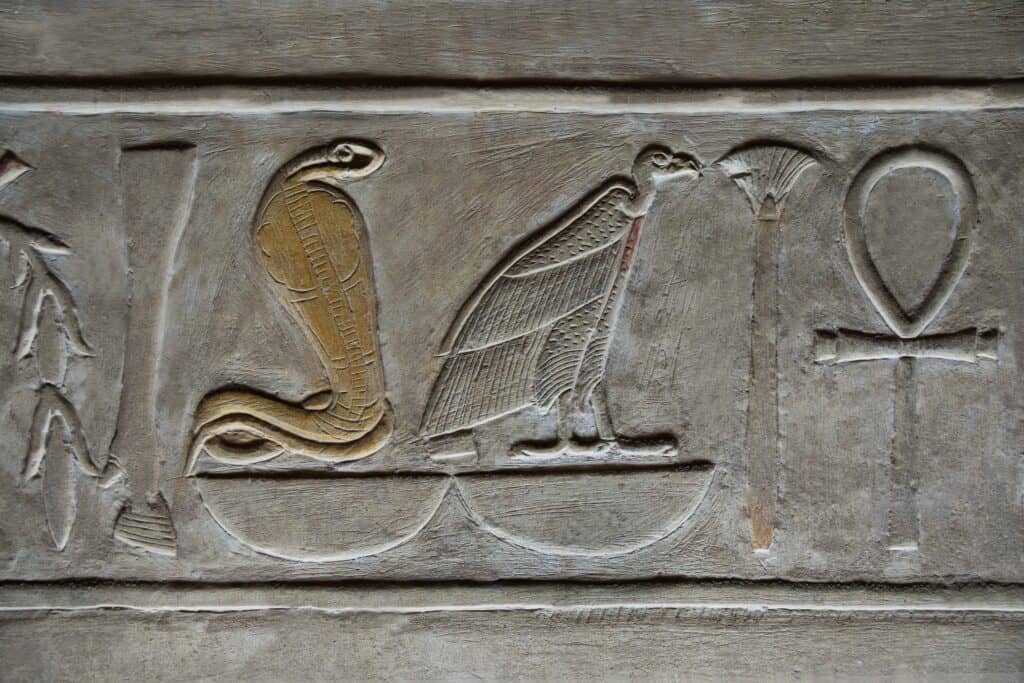Many animals have several common names, a fact that causes endless amounts of confusion. Take the cottonmouth and water moccasin snake — two names, same snake. This is but one example of humanity’s propensity for giving everything a name or a nickname. We like names. This is why scientists who study the natural world prefer using scientific names when they really need someone to understand which animal they’re discussing.

Egyptian cobra, aka the Egyptian asp, is brown, black, or banded with both colors.
©OPIS Zagreb/Shutterstock.com
Characteristics of Egyptian Asps and Egyptian Cobras
The Egyptian asp is a highly venomous member of the Elapidae family Naja haje. If you remember anything about the elapids, you’ll remember that Naja is the genus where scientists classify true cobras. Except for the king cobra, which is a different genus altogether, cobras typically range from six to10 feet long.
Egyptian asps are the second-longest cobra on the African continent, reaching about eight feet long. The forest cobra is the only true cobra that gets bigger and has been recorded at 10 feet, but that’s rare.

Forest cobras are the only true cobra in Africa that grows longer than the Egyptian cobra, reaching lengths of up to 10 feet.
©reptiles4all/Shutterstock.com
Egyptian Asp and Egyptian Cobra Behavior
This is not an aggressive species. When Egyptian cobras feel threatened, they spread their hood and can raise up to a third of their body length off the ground. While this looks terrifying, it’s more of a defensive display than an aggressive maneuver. They’re trying to make themselves look bigger to scare you away. They don’t really want to bite, most cobras would rather escape and try very hard to do so. It’s only when they can’t get away that they see biting as an option.
Like nearly all snakes, Egyptian cobras are solitary animals. The only time they come together is during mating season. After mating, the females find a quiet spot and lay up to 33 eggs per clutch. When they hatch, the babies are ready to be on their own and even have fully-functional venom glands — and know how to use them.
Deadly Venom
Egyptian cobra venom is a deadly mix of neurotoxins and cytotoxins. This species injects between 175 and 300 mg of venom in a single bite. Envenomation symptoms include tissue necrosis, convulsions, nausea, and a host of other issues. Neurotoxins are the main issue with their venom because it interrupts the nervous signal going to the muscles. In later stages, this can cause the heart and lungs to fail. Of course, by the time it reaches this stage, death may be a welcome respite from the pain.
It was sometimes used to execute prisoners in ancient Egypt. Fortunately for us, not only is this a shy snake, but it also can’t spit venom.
Egyptian Asp in History and Culture
The Egyptian asp appears repeatedly throughout ancient Egyptian hieroglyphs and beliefs. The cobra was a symbol of royalty and its likeness adorned the pharaoh’s crown, many walls in and around their palaces, and burial chambers. It was feared and revered, often in the same moment. Their connection to divinity and their deadly bite made it easy to feel this way about them.
Yet, their notoriety extended beyond the lives of the pharaohs like Ramses II. They have also been called Cleopatra’s asp. Legend has it that this is the species Cleopatra used to kill herself before her rule fell to Julius Caesar.
However, that idea has been questioned because the snake is large. It wouldn’t be easy to smuggle one into her palace when she was under house arrest by the Romans. While you could argue that a baby snake would be just as effective and easier to smuggle, death by envenomation by an Egyptian cobra isn’t quick, nor is it painless.
Today, cobras are still respected and feared by the people who live near them, and with good reason. While these snakes work very hard to avoid people, inevitably, encounters happen. If the individual stays calm and hasn’t terrified the snake, the snake is probably happy to get away and nobody has to get bitten. However, if the snake is startled, then it may feel threatened enough to strike.

Egyptian cobras were often depicted in hieroglyphics.
©hemro/Shutterstock.com
Egyptian Asp and Egyptian Cobra: The Same Animal, Different Name
As with other animals, this snake has multiple names. Yet, the two that have caused the most confusion are “asp” and “cobra.” To understand more, we have to dig into the etymology and go back a couple of thousand years.
The word asp is related to the Latin word aspis, and to the even older Greek word aspis. Aspis, in all its forms, means a round shield. According to Etymology Online, the word was first used in the form aspis in reference to venomous snakes in Egypt in about the 12th century. Some argue that its origin refers to the round, shield-shaped hood that cobras (asps) exhibit. However, others say there isn’t enough evidence to support that hypothesis.
To add to the confusion, from about the 15th century the word asp was applied rather liberally across Europe referring to any venomous snake. Then, as we learned more about science and the desire for precision in scientific language grew, we refined its use to just a few species in Europe like the viper asp and a few others from the Vipera genus.
Cobra has a somewhat parallel history.
The word cobra is a descendant of a Latin word, colubra, which means serpent or snake. In an ironic, but totally normal turn of events, colubra is the root of the French word coleuvre which means adder. The origin of the word colubra is unclear. Yet, how it became cobra is more clear.
The Portuguese took on the word and, over the years, it became cobra, a generic word for any serpent. When the Portuguese encountered venomous cobras that rise up and spread their hoods in their travels, they called it cobra de capello, which translates as “serpent of the hood.”
In time, even that became shortened to cobra.
At this point, it’s probably more commonly called the Egyptian cobra. Yet, if you’ve found this page while searching for information about Cleopatra’s asp for your history class, you may disagree. Common names have a tendency to grow and change with time. This isn’t a surprise, though, because language is a living entity. It grows and changes with the people who use it. We use ancient Greek and Latin in science because they aren’t growing and changing anymore. The people who spoke them are long gone, buried in the sands of time.
Up Next
- Cottonmouth vs. Rattlesnake: 5 Key Differences
- King Cobra vs Rattlesnake: 5 Key Differences
- Coral Snake vs Kingsnake: 5 Key Differences Explained
The photo featured at the top of this post is © Julian W/Shutterstock.com
Discover the "Monster" Snake 5X Bigger than an Anaconda
Every day A-Z Animals sends out some of the most incredible facts in the world from our free newsletter. Want to discover the 10 most beautiful snakes in the world, a "snake island" where you're never more than 3 feet from danger, or a "monster" snake 5X larger than an anaconda? Then sign up right now and you'll start receiving our daily newsletter absolutely free.
Thank you for reading! Have some feedback for us? Contact the AZ Animals editorial team.






